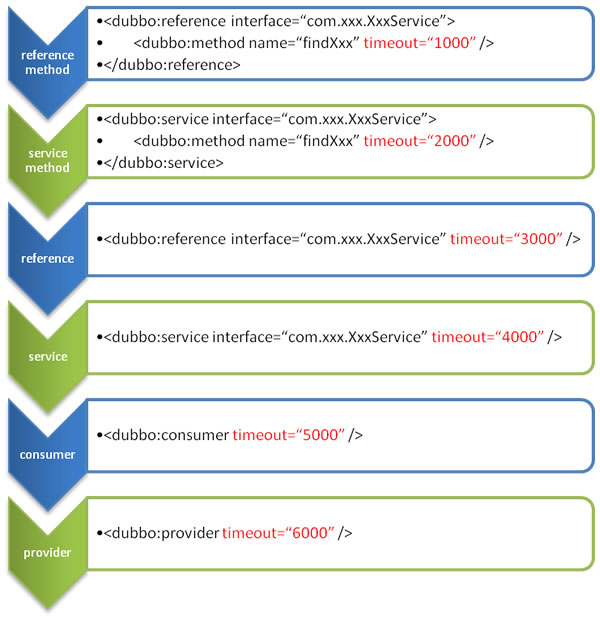该文章内容发布已经超过一年,请注意检查文章中内容是否过时。
Dubbo 中的 URL 统一模型
定义
在不谈及 dubbo 时,我们大多数人对 URL 这个概念并不会感到陌生。统一资源定位器 (RFC1738――Uniform Resource Locators (URL))应该是最广为人知的一个 RFC 规范,它的定义也非常简单
因特网上的可用资源可以用简单字符串来表示,该文档就是描述了这种字符串的语法和语 义。而这些字符串则被称为:“统一资源定位器”(URL)
一个标准的 URL 格式至多可以包含如下的几个部分
protocol://username:password@host:port/path?key=value&key=value
一些典型 URL
http://www.facebook.com/friends?param1=value1&param2=value2
https://username:password@10.20.130.230:8080/list?version=1.0.0
ftp://username:password@192.168.1.7:21/1/read.txt
当然,也有一些不太符合常规的 URL,也被归类到了 URL 之中
192.168.1.3:20880
url protocol = null, url host = 192.168.1.3, port = 20880, url path = null
file:///home/user1/router.js?type=script
url protocol = file, url host = null, url path = home/user1/router.js
file://home/user1/router.js?type=script<br>
url protocol = file, url host = home, url path = user1/router.js
file:///D:/1/router.js?type=script
url protocol = file, url host = null, url path = D:/1/router.js
file:/D:/1/router.js?type=script
同上 file:///D:/1/router.js?type=script
/home/user1/router.js?type=script
url protocol = null, url host = null, url path = home/user1/router.js
home/user1/router.js?type=script
url protocol = null, url host = home, url path = user1/router.js
Dubbo 中的 URL
在 dubbo 中,也使用了类似的 URL,主要用于在各个扩展点之间传递数据,组成此 URL 对象的具体参数如下:
- protocol:一般是 dubbo 中的各种协议 如:dubbo thrift http zk
- username/password:用户名/密码
- host/port:主机/端口
- path:接口名称
- parameters:参数键值对
public URL(String protocol, String username, String password, String host, int port, String path, Map<String, String> parameters) {
if ((username == null || username.length() == 0)
&& password != null && password.length() > 0) {
throw new IllegalArgumentException("Invalid url, password without username!");
}
this.protocol = protocol;
this.username = username;
this.password = password;
this.host = host;
this.port = (port < 0 ? 0 : port);
this.path = path;
// trim the beginning "/"
while(path != null && path.startsWith("/")) {
path = path.substring(1);
}
if (parameters == null) {
parameters = new HashMap<String, String>();
} else {
parameters = new HashMap<String, String>(parameters);
}
this.parameters = Collections.unmodifiableMap(parameters);
}
可以看出,dubbo 认为 protocol,username,passwored,host,port,path 是主要的 URL 参数,其他键值对存放在 parameters 之中。
一些典型的 Dubbo URL
dubbo://192.168.1.6:20880/moe.cnkirito.sample.HelloService?timeout=3000
描述一个 dubbo 协议的服务
zookeeper://127.0.0.1:2181/org.apache.dubbo.registry.RegistryService?application=demo-consumer&dubbo=2.0.2&interface=org.apache.dubbo.registry.RegistryService&pid=1214&qos.port=33333×tamp=1545721981946
描述一个 zookeeper 注册中心
consumer://30.5.120.217/org.apache.dubbo.demo.DemoService?application=demo-consumer&category=consumers&check=false&dubbo=2.0.2&interface=org.apache.dubbo.demo.DemoService&methods=sayHello&pid=1209&qos.port=33333&side=consumer×tamp=1545721827784
描述一个消费者
可以说,任意的一个领域中的一个实现都可以认为是一类 URL,dubbo 使用 URL 来统一描述了元数据,配置信息,贯穿在整个框架之中。
URL 相关的生命周期
RPC调用
从地址发现的视角,URL 代表了一条可用的 provider 实例地址,除了地址信息之外还有相关的配置信息,这些配置信息是层次化的,有 provider 侧指定的配置值、consumer 侧指定的配置值、接口级别的配置值、方法级别的配置值等。这些 URL 配置值将直接影响消费端的 RPC 调用行为。
以 timeout 为例,下图显示了配置的查找顺序,其它 retries, loadbalance, actives 等类似:
- 方法级优先,接口级次之,全局配置再次之。
- 如果级别一样,则消费方优先,提供方次之。
其中,服务提供方配置,通过 URL 经由注册中心传递给消费方。

(建议由服务提供方设置超时,因为一个方法需要执行多长时间,服务提供方更清楚,如果一个消费方同时引用多个服务,就不需要关心每个服务的超时设置)。
理论上 ReferenceConfig 中除了interface这一项,其他所有配置项都可以缺省不配置,框架会自动使用ConsumerConfig,ServiceConfig, ProviderConfig等提供的缺省配置。
解析服务
基于 dubbo.jar 内的 META-INF/spring.handlers 配置,Spring 在遇到 dubbo 名称空间时,会回调 DubboNamespaceHandler。
所有 dubbo 的标签,都统一用 DubboBeanDefinitionParser 进行解析,基于一对一属性映射,将 XML 标签解析为 Bean 对象。
在 ServiceConfig.export() 或 ReferenceConfig.get() 初始化时,将 Bean 对象转换 URL 格式,所有 Bean 属性转成 URL 的参数。
然后将 URL 传给协议扩展点,基于扩展点自适应机制,根据 URL 的协议头,进行不同协议的服务暴露或引用。
暴露服务
1. 只暴露服务端口:
在没有注册中心,直接暴露提供者的情况下,ServiceConfig 解析出的 URL 的格式为:dubbo://service-host/com.foo.FooService?version=1.0.0。
基于扩展点自适应机制,通过 URL 的 dubbo:// 协议头识别,直接调用 DubboProtocol的 export() 方法,打开服务端口。
2. 向注册中心暴露服务:
在有注册中心,需要注册提供者地址的情况下,ServiceConfig 解析出的 URL 的格式为: registry://registry-host/org.apache.dubbo.registry.RegistryService?export=URL.encode("dubbo://service-host/com.foo.FooService?version=1.0.0"),
基于扩展点自适应机制,通过 URL 的 registry:// 协议头识别,就会调用 RegistryProtocol 的 export() 方法,将 export 参数中的提供者 URL,先注册到注册中心。
再重新传给 Protocol 扩展点进行暴露: dubbo://service-host/com.foo.FooService?version=1.0.0,然后基于扩展点自适应机制,通过提供者 URL 的 dubbo:// 协议头识别,就会调用 DubboProtocol 的 export() 方法,打开服务端口。
引用服务
1. 直连引用服务:
在没有注册中心,直连提供者的情况下,ReferenceConfig 解析出的 URL 的格式为:dubbo://service-host/com.foo.FooService?version=1.0.0。
基于扩展点自适应机制,通过 URL 的 dubbo:// 协议头识别,直接调用 DubboProtocol 的 refer() 方法,返回提供者引用。
2. 从注册中心发现引用服务:
在有注册中心,通过注册中心发现提供者地址的情况下,ReferenceConfig 解析出的 URL 的格式为:registry://registry-host/org.apache.dubbo.registry.RegistryService?refer=URL.encode("consumer://consumer-host/com.foo.FooService?version=1.0.0")。
基于扩展点自适应机制,通过 URL 的 registry:// 协议头识别,就会调用 RegistryProtocol 的 refer() 方法,基于 refer 参数中的条件,查询提供者 URL,如: dubbo://service-host/com.foo.FooService?version=1.0.0。
基于扩展点自适应机制,通过提供者 URL 的 dubbo:// 协议头识别,就会调用 DubboProtocol 的 refer() 方法,得到提供者引用。
然后 RegistryProtocol 将多个提供者引用,通过 Cluster 扩展点,伪装成单个提供者引用返回。
URL 统一模型的意义
对于 dubbo 中的 URL,有人理解为配置总线,有人理解为统一配置模型,说法虽然不同,但都是在表达一个意思,这样的 URL 在 dubbo 中被当做是公共契约,所有扩展点参数都包含 URL 参数,URL 作为上下文信息贯穿整个扩展点设计体系。
在没有 URL 之前,只能以字符串传递参数,不停的解析和拼装,导致相同类型的接口,参数时而 Map, 时而 Parameters 类包装:
export(String url)
createExporter(String host, int port, Parameters params)
使用 URL 一致性模型:
export(URL url)
createExporter(URL url)
在最新的 dubbo 代码中,我们可以看到大量使用 URL 来进行上下文之间信息的传递,这样的好处是显而易见的:
- 使得代码编写者和阅读者能够将一系列的参数联系起来,进而形成规范,使得代码易写,易读。
- 可扩展性强,URL 相当于参数的集合(相当于一个 Map),他所表达的含义比单个参数更丰富,当我们在扩展代码时,可以将新的参数追加到 URL 之中,而不需要改变入参,返参的结构。
- 统一模型,它位于 org.apache.dubbo.common 包中,各个扩展模块都可以使用它作为参数的表达形式,简化了概念,降低了代码的理解成本。
如果你能够理解 final 契约和 restful 契约,那我相信你会很好地理解 URL 契约。契约的好处我还是啰嗦一句:大家都这么做,就形成了默契,沟通是一件很麻烦的事,统一 URL 模型可以省去很多沟通成本,这边是 URL 统一模型存在的意义。